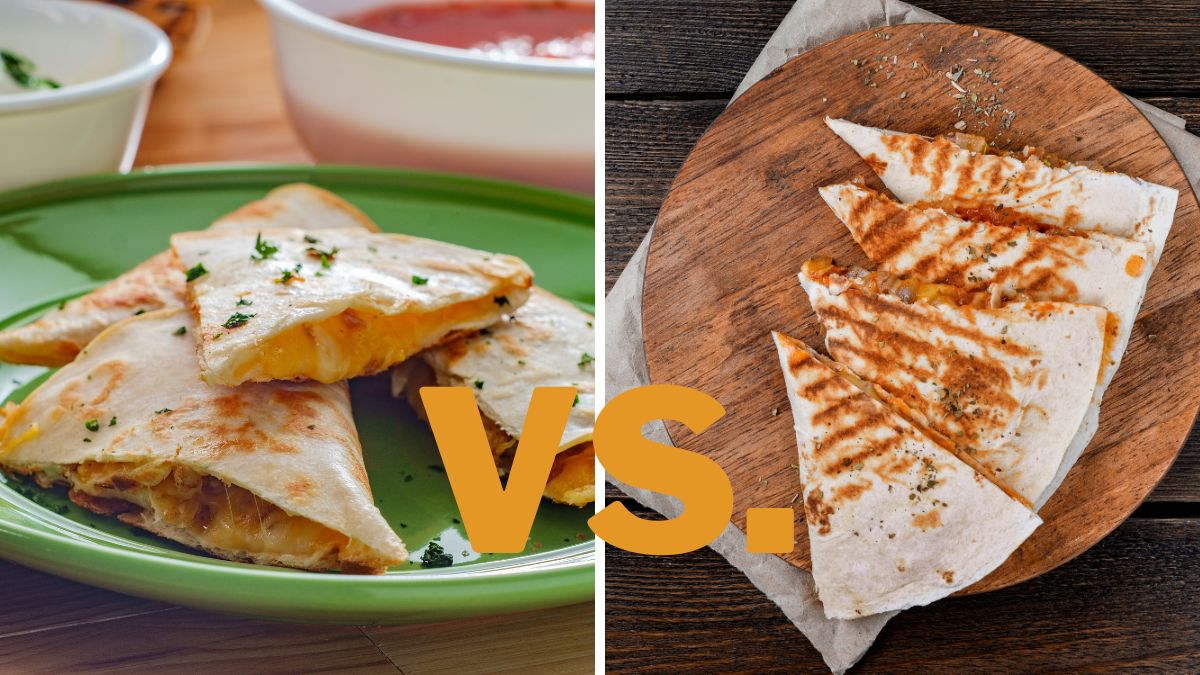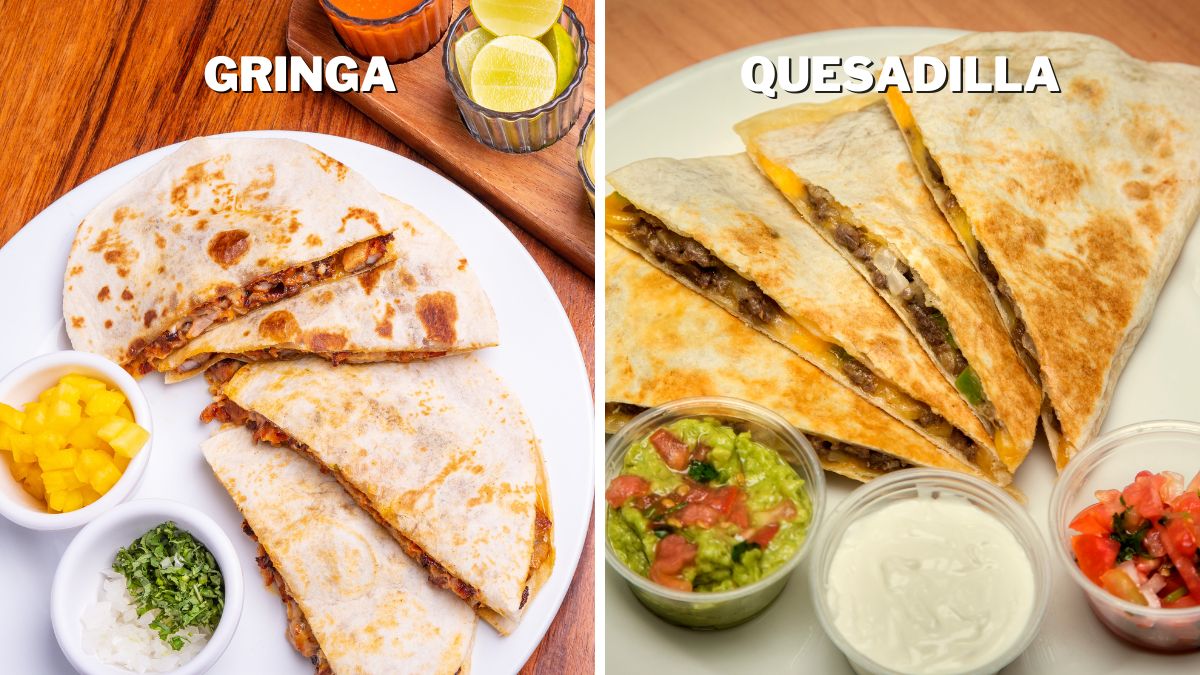Gringa vs. Quesadilla: Differences Revealed

Gringa and quesadilla are both Latin delicacies that I love making as much as I love eating. Similar in appearance, they are often mistaken for the same thing, even though they are two individual dishes deserving of proper attention and admiration. After the countless debates I’ve had explaining the differences, I decided to put them on paper, or rather on screen, and clear the air once and for all. So, finally, what are the differences between gringa and quesadilla?
Gringas are folded tortilla sandwiches with marinated meat, melted cheese, and sometimes pineapple. Quesadillas are half-moon shaped, filled with various fillings like meats, vegetables, and cheese, enclosed in a toasted tortilla.
Since both are on the top of my list, I won’t compare gringa and quesadilla and tell you which is better, but simply highlight the differences that make them so uniquely delicious. So, if you want to know more about these delicacies, stay around. In this article, I will tell you all about the specificities of these two dishes, their differences, and their similarities.
Taste

We’re kicking off this list of differences with the most essential feature- the taste. You don’t have to be a food expert to notice the difference in taste between gringa and quesadilla.
Since gringas are made with marinated, spit-roasted meat tucked between two flour tortillas with melted cheese, they are savory, robust, tangy, and overall intense. The melted cheese, although very noticeable, has more of a supportive role, accentuating and intensifying the juices from the meat.
Quesadillas are typically lighter in flavor since they can be made from various ingredients, and meat isn’t a compulsory element, though I prefer them meaty. I can’t describe them as a unified flavor profile due to the variability of the filling, but they are generally juicy and excellently balanced.
Like gringas, quesadillas too feature cheese that enriches the flavor. The cheese in the quesadilla is more pronounced compared to the gringas because the quesadilla filling is often less intense than that of the gringas.
Origin
The origin is another important difference between gringas and quesadillas. Gringas are believed to have originated in the street food scene of Mexico City and have a far shorter history than quesadillas. They are considered fast food, though today, they are fully integrated into Mexican cuisine.
Quesadillas, on the other hand, are deeply rooted in Mexican cuisine, dating back to the 16th century. The precise origin and how they came into existence are still discussed, but the fact remains that this delicacy has been around for centuries.
Serving

The traditional serving is another aspect in which gringas and quesadillas differ. Since gringas originate from more recent times, they are accompanied by sides that are more typical for fast food, such as melted cheese, sometimes sliced pineapple, as well as salsas, guacamole, and other condiments.
I usually go simple with a few bowls of different dipping sauces depending on my mood and who I am sharing the experience with.
Quesadillas are more versatile in terms of serving, and you can serve them with sauces, veggies, toppings, or as a side of another dish. In the olden days, they were commonly accompanied by salsas, crema, and a variety of garnishes.
Nutritional Properties
In terms of nutrition, I can’t say that any of these dishes are especially great choices as they both include carbs and fried ingredients, though they are immensely delicious. On the other hand, they aren’t overly fatty, which means that nothing would happen if you occasionally treat yourself to one or both of them.
Gringas, however, tend to be more substantial due to the meat and cheese fillings, making them the more satiating option. Due to the generous amounts of meat and cheese, they offer some protein but also fats.
The nutritional properties of the quesadilla vary depending on the filling. They do contain carbs because of the tortillas and some protein resulting from the cheese. The other nutritional elements are tied to the filling in question.
Popularity
When it comes to popularity, quesadillas, and gringas are both very popular. I’ve had them in many Mexican restaurants, which is how I know that they feature on the menus of almost all of them. They are also very popular in the households because I’ve attended many Mexican nights, and they were there.
I make them at least twice a month, and many of my friends have called me for the recipe; I guess the word spreads quickly when it comes to delicious and easy-to-make food.
Appearance
Appearance is where the misunderstanding occurs because they often seem very similar. Gringas are often larger in size and are made by stacking two meat-filled flour tortillas with melted cheese and sometimes slices of pineapple in between.
Still, the pineapple isn’t a standard member of the combination, which makes the resemblance even greater.
Quesadillas come in various forms – folded or open-faced. When folded, they have a half-moon shape, and when toasted, they have a golden-brown crust.
Ingredients and Preparation
Gringas are made with marinated meat, a flour tortilla, cheese, and occasionally a slice of pineapple. The tortillas are filled with meat and stacked onto each other. The pineapple comes in between the tortillas but isn’t mandatory.
The whole thing is then covered in melted cheese, creating a rich and creamy dish. I don’t always add pineapple because not everyone is a fan of the taste, so this element is very subjective and depends on what you and your guests like.
Quesadillas can be made with various ingredients and can contain meat or just veggies. I prefer them with minced beef, mushrooms, and sautéed onions. You can also make them with fruit filling if that’s what you like.
Anyway, the tortillas are filled and folded in half, toasted, and with various toppings or melted cheese.
Now, it’s your time to talk. Tell us which one you prefer and why in the comment section below. 🙂
